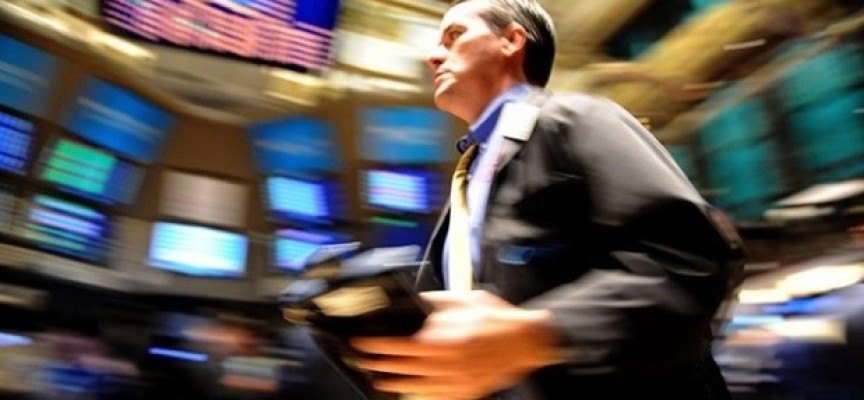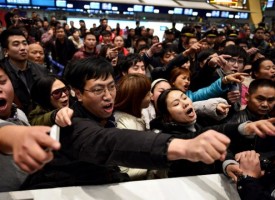On the heels of Friday's huge global stock market selloff, today a legend in the business sent King World News a powerful piece discussing what the public was doing during the worldwide plunge in equity prices and it will surprise you!
From Art Cashin's notes: The bulls had their balloon shot out of the air Friday and it was not just in the United States. While the Dow fell 279 points, losses in Europe were worse. Spain was down the Dow equivalent of 392 points, Italy 434 and Germany 467.
The factors were the ones I noted in Friday morning’s pre-opening Comments. First, was the post-close decision by Chinese authorities to ban some margin trading and expand the list of stocks that could be sold short. Second, there were contentions of press reports that European banking authorities directed many banks to liquidate their holdings of Greek sovereign debt. That raised speculation that the Greek negotiations might work out negatively, shortly.
We also mentioned a third factor. That was the broad disruption of trading that occurred with a global outage of Bloomberg trading terminals. Some of the media was skeptical of the influence of the terminal outage. However, the outage came just as Europe was opening amid the Greek rumors and the China announcement.
I can tell you based on over five decades of trading, mechanical or electronic outages that inhibit trading at a key news point can be as disruptive as any flash crash. Let me clarify more directly. A disruption like the Bloomberg outage does not cause selling, but it does inhibit buyers who do not want to establish a new position that they could find themselves trapped in by a non-functioning mechanism.
At any rate, U.S. stocks opened sharply lower and continued lower until about 10:15, when they moved warily sideways, watching their European brethren. The day’s evolving events inspired me to send a series of explanatory notes, which take up too much room to cite individually, so I’ll try to partially synopsize them.
The first concerned the anomaly of the yield on the ten year rising when it intuitively should have fallen on a “flight to safety”. I chalked the anomaly to what I called the “Fischer Factor”, as the 1.8% bump in CPI fit perfectly into Fischer’s comments in an interview with CNBC’s Sara Eisen that inflation was very close to the Fed’s 2% target and thus rates could be raised. I suggested that the flight to safety factor might overcome the Fischer factor, which it did handily by day’s end.
I next discussed that traders would look to the 11:30 European close to see if selling abated. No relief ensued and then we pointed to a key support area in the S&P of 2082/2086. The S&P tested but easily broke and moved to the day’s lows. As the afternoon wore on, stocks started to regroup as traders learned that Expiration posed no heavy selling, so stocks tried to lift. I suggested the broken support at 2082/2086 would now prove resistance. Conveniently, the closing rally flamed out within that band and the S&P closed at 2081. A day of volatility, indeed.
Who Was Buying Friday? Maybe Not Whom You Think – The always sharp-eyed Nicholas Colas, Chief Market Strategist over at Convergex pondered who might be selling in Friday's waterfall plunge. What he discovered suggested that it was not retail investors. Here's a bit of what he wrote in his latest note:
Take as a mini case study the action from Friday’s sell off. I regularly look at the daily trading trends available on one large online broker’s website – Fidelity’s retail portal. The data posts every day in real time, so by the end of trading hours you have a snapshot of what this particular brokerage has seen in terms of order flow through the day. The top 10 names traded are visible to anyone with or without a brokerage account at the company – the remaining 20 names require an account ($2,500 minimum).
A few key takeaways from the data:
- Retail investors still trade a lot of single stocks, rather than exchange traded funds. Of the top 30 names in terms of the number of orders, only 5 are ETFs. The rest are all individual company equities.
- The top three names in terms of order flow on Friday were Apple, Netflix and Facebook. To give a sense of scale, Apple had 72% buy orders and 28% sell orders on Friday. Netflix was paired more closely, at 53% buy orders and 47% sells. Facebook orders skewed more to the buyside as well: 71% to 29% sells.
- The ETF with the most retail interest based on this data was SPY, with 61% buy versus 39% sell orders. The only other ETF name in the top 10 is UVXY – the ProShares Ultra VIX Short Term Futures – with 30% of the order flow as buys and the rest as sells.
- Taken as a whole, retail investors were net buyers of the top 30 names on this list during Friday’s volatile session. In terms of single stocks, retail was a small net seller of just two names – Microsoft and Schlumberger – and hardly in enough size to be meaningful.
- Rounding out the Top 10 list (those available on public access to the Fidelity website): GE, Alibaba, American Express, AT&T, and Bank of America.
I know we can’t take one day – even a volatile one – and put too much weight on the data to extrapolate larger trends. At the same time, the long term is just a bunch of short terms strung together. Friday’s volatile action should have been exactly the kind of churn that spooks retail investors. There were, for example, very few satisfying explanations for the +1.5% drop in the S&P 500 through 2pm, or the 50 basis point snapback into the close. And yet, the data is clear: retail bought this dip.
As Nick notes, it is a small sample but it raises doubts about the long standing presumption of a panicky public.
Consensus – Cut in China's reserve requirements could be powerful monetary medicine but may get blurred by somewhat dysfunctional banking and currency pressures. WTI crude needs to break above $57.50 to break range. Oversold rebound looks likely but too early for the all clear signal. Stay wary, alert and very, very nimble. ***ALSO JUST RELEASED: Is The World Being Set Up For Something Even More Terrifying Than The Global Stock Market Crash Of 1987? CLICK HERE.
© 2015 by King World News®. All Rights Reserved. This material may not be published, broadcast, rewritten, or redistributed. However, linking directly to the blog page is permitted and encouraged.
The audio interviews with Gerald Celente, Egon von Greyerz, Dr. Paul Craig Roberts, Andrew Maguire, James Turk, Rick Rule, Bill Fleckenstein, Dr. Philippa Malmgren, Eric Sprott, Robert Arnott, Michael Pento, David Stockman, Marc Faber, Felix Zulauf, John Mauldin, John Embry and Rick Santelli are available now. Other recent KWN interviews include Jim Grant — to listen CLICK HERE.







